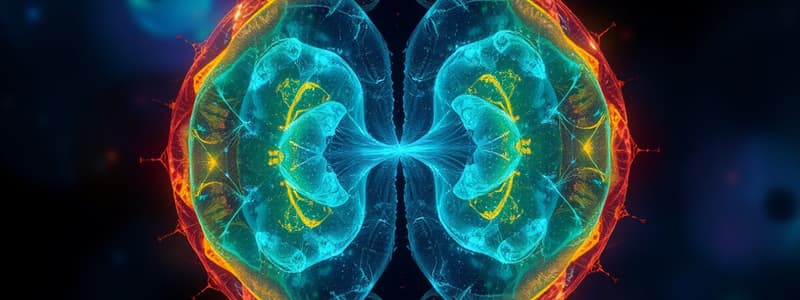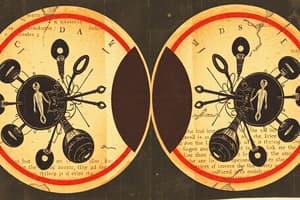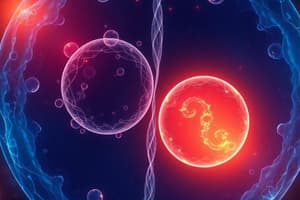Podcast
Questions and Answers
What does the pelvic cavity contain?
What does the pelvic cavity contain?
Urinary bladder, reproductive organs, part of large intestine
Match the following serous membranes with their corresponding cavities:
Match the following serous membranes with their corresponding cavities:
Pericardium = Pericardial Cavity Pleura = Pleural Cavity Peritoneum = Peritoneal Cavity
What type of membrane covers the organs?
What type of membrane covers the organs?
Visceral serous membrane
What is the function of the pericardial cavity?
What is the function of the pericardial cavity?
What are the two layers of the peritoneum?
What are the two layers of the peritoneum?
What does the pleural cavity do?
What does the pleural cavity do?
What does the term 'Anatomy' mean?
What does the term 'Anatomy' mean?
Which of the following is NOT a level of structural organization in the body?
Which of the following is NOT a level of structural organization in the body?
What is the basic unit of life?
What is the basic unit of life?
What are the four broad types of tissue?
What are the four broad types of tissue?
The cardiovascular system _ nutrients throughout the body.
The cardiovascular system _ nutrients throughout the body.
The skeletal system is responsible for protection and support.
The skeletal system is responsible for protection and support.
Which system is responsible for the regulation of temperature and water loss?
Which system is responsible for the regulation of temperature and water loss?
What is homeostasis?
What is homeostasis?
What is the normal range for body temperature?
What is the normal range for body temperature?
Match the systems with their main functions:
Match the systems with their main functions:
What is a receptor in the feedback system?
What is a receptor in the feedback system?
Which is an example of positive feedback?
Which is an example of positive feedback?
The _ plane separates the body into right and left parts.
The _ plane separates the body into right and left parts.
Study Notes
Cell Division: Mitosis and Meiosis
- Daughter cells are formed from a single parent cell through cell division.
- Mitosis produces two genetically identical daughter cells, while meiosis produces four non-identical haploid cells, or gametes.
- Mitosis is essential for growth and tissue repair, meiosis is crucial for sexual reproduction.
Mitosis Process
- Mitosis begins with prophase, where chromosomes condense and become visible.
- The nucleolus disappears, and the mitotic spindle, composed of microtubules, forms to move chromosomes.
- Chromosomes align along the metaphase plate at the cell's center during metaphase.
- Microtubules pull apart sister chromatids, separating each chromosome into two identical units, a process termed independent segregation.
Meiosis Process
- Meiosis starts with a diploid cell dividing to produce four haploid daughter cells, each with a single set of chromosomes.
- The first division, meiosis I, involves the pairing of homologous chromosomes, forming pairs that align meticulously.
- Crossing over occurs where homologous chromosomes exchange genetic material, increasing genetic diversity.
Key Stages of Meiosis
- Early prophase I: Chromosomes condense, and homologous chromosome pairs form.
- Metaphase I: Homologous pairs align at the metaphase plate.
- Anaphase I: Homologous pairs are separated and pulled to opposite ends of the cell.
- Telophase I results in two non-identical haploid daughter cells.
- Meiosis II follows, leading to a second division that separates sister chromatids into four unique daughter cells with 23 chromosomes each.
Final Outcome
- The complete process of meiosis results in four haploid cells, critical for sexual reproduction, with sperm and egg cells representing the final products.
- Genetic diversity in daughter cells is enhanced through mechanisms like crossing over and independent assortment during meiosis.
Anatomy and Physiology
- Anatomy investigates the structure of the body and means "to dissect."
- Physiology examines processes and functions within the human body.
- Human Physiology focuses on the human organism.
Structural and Functional Organization
- Organization is structured across six levels, from chemical to organism.
- Chemical Level: Involves atoms, molecules, and the smallest units of life.
- Cellular Level: Cells are the basic units of life, containing organelles like mitochondria and the nucleus.
- Tissue Level: Comprises groups of similar cells with collective functions. Four major types include epithelial, connective, muscular, and nervous tissues.
- Organ Level: Two or more tissue types working together, such as the stomach or heart.
- Organ System Level: Groups of organs performing related functions, e.g., digestive system.
- Organism Level: Represents all organ systems functioning together and includes associated microorganisms.
Types of Anatomy
- Systemic Anatomy: Studies organ systems.
- Surface Anatomy: Focuses on external features and landmarks.
- Regional Anatomy: Studies specific body regions comprehensively.
- Anatomical Imaging: Utilizes technology (e.g., X-rays, MRI) to visualize internal structures.
Homeostasis
- Defined as maintaining a stable internal environment despite external fluctuations.
- Variables: Measures that can change, such as heart rate and blood pressure.
- Normal Range: Extent of variation around a set point.
- Set Point: Average value for physiological parameters, fluctuating within a normal range.
Feedback Mechanisms
- Negative Feedback: Restores the body to a set point after a deviation; involves a receptor, control center, and effector.
- Positive Feedback: Amplifies a response away from the set point, not generally used for maintenance of homeostasis; examples include childbirth.
Body Planes and Directional Terms
- Sagittal Plane: Divides body into right and left parts.
- Median Plane: A sagittal plane along the midline creating equal halves.
- Transverse Plane: Separates the body into superior and inferior parts.
- Frontal Plane: Divides the body into anterior and posterior parts.
Body Regions and Cavities
- Upper and lower limbs are distinct regions, with the central region encompassing the head, neck, and trunk.
- Thoracic Cavity: Contains lungs, heart, and major vessels.
- Abdominal Cavity: Houses the stomach, intestines, and other organs.
- Pelvic Cavity: Contains reproductive organs and urinary bladder.
Serous Membranes
- Cover trunk cavities and organs, reducing friction.
- Visceral Membrane: Covers the organs.
- Parietal Membrane: Lines the cavity wall.
- Cavity: The fluid-filled space between membranes.
- Pericardium: Surrounds the heart; reduces friction.
- Pleura: Surrounds the lungs; aids lung adherence to thoracic wall.
- Peritoneum: Encases the abdominopelvic cavity and its organs.
Studying That Suits You
Use AI to generate personalized quizzes and flashcards to suit your learning preferences.
Description
Explore the fundamental processes of mitosis and meiosis in this quiz. Understand how daughter cells are formed, the roles of chromatids, and the stages involved in cell division. This quiz is essential for students studying biology and helps clarify the mechanisms of growth and reproduction.




